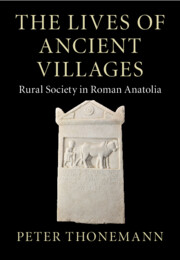Refine search
Actions for selected content:
23990 results in Ancient history
Epistula 3
-
- Book:
- Sidonius Apollinaris' Letters, Book 2
- Published by:
- Edinburgh University Press
- Published online:
- 14 July 2023
- Print publication:
- 31 October 2022, pp 178-188
-
- Chapter
- Export citation
List of Abbreviations
-
- Book:
- Amnesty and Reconciliation in Late Fifth-Century Athens
- Published by:
- Edinburgh University Press
- Published online:
- 03 June 2023
- Print publication:
- 31 October 2022, pp x-xii
-
- Chapter
- Export citation
5 - In the Name of Jesus of Nazareth the Crucified: Ritual Practitioners Who Offered Cures
-
- Book:
- Contested Cures
- Published by:
- Edinburgh University Press
- Published online:
- 03 June 2023
- Print publication:
- 31 October 2022, pp 117-148
-
- Chapter
- Export citation
Epistula 8
-
- Book:
- Sidonius Apollinaris' Letters, Book 2
- Published by:
- Edinburgh University Press
- Published online:
- 14 July 2023
- Print publication:
- 31 October 2022, pp 217-245
-
- Chapter
- Export citation
5 - Performing Byzantine Identity: Gender, Status and the Cult of the Virgin
-
-
- Book:
- Identities and Ideologies in the Medieval East Roman World
- Published by:
- Edinburgh University Press
- Published online:
- 25 January 2025
- Print publication:
- 31 October 2022, pp 129-145
-
- Chapter
- Export citation
Appendix 3 - The Khazar-Ashkenazi Descent Theory
-
- Book:
- The Monotheisation of Pontic-Caspian Eurasia
- Published by:
- Edinburgh University Press
- Published online:
- 25 October 2023
- Print publication:
- 31 October 2022, pp 193-205
-
- Chapter
- Export citation
Epilogue: A Time of Handwashing
-
- Book:
- Pontius Pilate on Screen
- Published by:
- Edinburgh University Press
- Published online:
- 03 June 2023
- Print publication:
- 31 October 2022, pp 257-263
-
- Chapter
- Export citation
List of Illustrations
-
- Book:
- Identities and Ideologies in the Medieval East Roman World
- Published by:
- Edinburgh University Press
- Published online:
- 25 January 2025
- Print publication:
- 31 October 2022, pp vii-ix
-
- Chapter
- Export citation
Frontmatter
-
- Book:
- Amnesty and Reconciliation in Late Fifth-Century Athens
- Published by:
- Edinburgh University Press
- Published online:
- 03 June 2023
- Print publication:
- 31 October 2022, pp i-iv
-
- Chapter
- Export citation

The Lives of Ancient Villages
- Rural Society in Roman Anatolia
-
- Published online:
- 28 October 2022
- Print publication:
- 17 November 2022

Procopius of Caesarea: The Persian Wars
- A Historical Commentary
-
- Published online:
- 20 October 2022
- Print publication:
- 10 November 2022
General Index
-
- Book:
- The Roman Emperor and his Court c. 30 BC–c. AD 300
- Published online:
- 29 September 2022
- Print publication:
- 20 October 2022, pp 289-296
-
- Chapter
- Export citation
12 - The Court and Ceremonial
-
-
- Book:
- The Roman Emperor and his Court c. 30 BC–c. AD 300
- Published online:
- 29 September 2022
- Print publication:
- 20 October 2022, pp 288-317
-
- Chapter
- Export citation
Glossary
-
- Book:
- The Roman Emperor and his Court c. 30 BC–c. AD 300
- Published online:
- 29 September 2022
- Print publication:
- 20 October 2022, pp xxxiii-xxxvi
-
- Chapter
- Export citation
10 - Imperial Villas
-
-
- Book:
- The Roman Emperor and his Court c. 30 BC–c. AD 300
- Published online:
- 29 September 2022
- Print publication:
- 20 October 2022, pp 239-266
-
- Chapter
- Export citation
List of Roman Emperors to c. AD 300
-
- Book:
- The Roman Emperor and his Court c. 30 BC–c. AD 300
- Published online:
- 29 September 2022
- Print publication:
- 20 October 2022, pp xix-xx
-
- Chapter
- Export citation
Bibliography
-
- Book:
- The Roman Emperor and his Court c. 30 BC–c. AD 300
- Published online:
- 29 September 2022
- Print publication:
- 20 October 2022, pp 249-276
-
- Chapter
- Export citation
Bibliography
-
- Book:
- The Roman Emperor and his Court c. 30 BC–c. AD 300
- Published online:
- 29 September 2022
- Print publication:
- 20 October 2022, pp 498-558
-
- Chapter
- Export citation
Index of Personal Names
-
- Book:
- The Roman Emperor and his Court c. 30 BC–c. AD 300
- Published online:
- 29 September 2022
- Print publication:
- 20 October 2022, pp 559-570
-
- Chapter
- Export citation
Acknowledgements
-
- Book:
- The Roman Emperor and his Court c. 30 BC–c. AD 300
- Published online:
- 29 September 2022
- Print publication:
- 20 October 2022, pp xiv-xv
-
- Chapter
- Export citation
